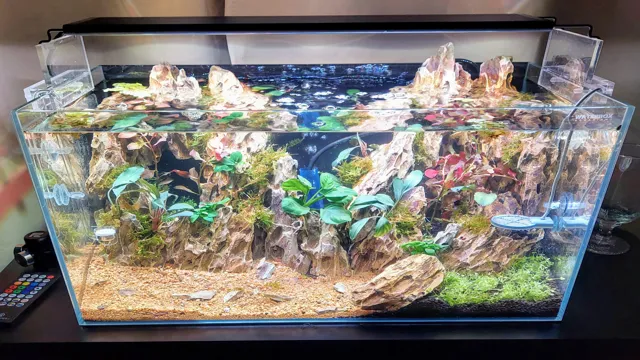Do you have an aquarium and wonder how many fish you can safely add? Or have you noticed your fish looking lethargic or acting strangely? The culprit could be an overloaded tank. Determining the bioload in your aquarium is crucial for a healthy and thriving aquatic environment. Bioload is the measure of the living organisms in a tank and the waste they produce.
As you add more fish or organisms to your aquarium, you increase the bioload, which can lead to poor water quality, stress, and even death for your aquatic pets. In this blog post, we’ll explore how to understand and calculate bioload in your aquarium, tips for managing it, and signs to look out for when it’s time to adjust. Keep reading to learn how to maintain a happy and healthy aquatic habitat for your underwater friends.
Understanding Bioload
Determining the bioload in your aquarium is crucial to maintaining a healthy environment for your aquatic pets. Bioload is the amount of organic waste produced by your fish, shrimp, snails, and other aquatic creatures. It is important to calculate the bioload before adding new fish to the tank, as too much waste can create toxic conditions for your pets.
One way to determine bioload is by calculating the total body weight of your aquatic pets. This includes all the fish, shrimp, and other creatures in your tank. You can then determine the amount of waste produced based on the type of organism and its size.
Another important factor to consider is the tank size, as a smaller aquarium will have a higher bioload than a larger one. By determining your aquarium’s bioload, you can ensure that you maintain a healthy environment for your aquatic pets and prevent any health issues that may arise from overloading your tank.
What is Bioload
Have you ever heard the term “bioload” before? Simply put, bioload is the amount of organic waste produced by living organisms in an aquarium. This waste includes uneaten food, fish excrement, and decaying plant material. Understanding bioload is crucial in maintaining a healthy aquatic environment for your fish and plants.
If there is too much waste and not enough beneficial bacteria to process it, harmful toxins can build up in the water, leading to issues like ammonia burns and fish illness. That’s why it’s important to only keep the appropriate number of fish in your tank based on its size and filtration system. By keeping an eye on your bioload and regularly performing water changes, you can keep your aquarium inhabitants happy and healthy.

Why is Bioload Important
Bioload is an essential aspect of aquarium keeping that every aquarium owner must understand. Simply put, bioload refers to the total amount of organic waste produced by fish and other aquatic life in an aquarium. This waste includes uneaten food particles, fecal matter, and decaying plant material.
A high bioload can affect water quality, leading to increased levels of ammonia, nitrite, and nitrate, which are harmful to aquatic life. To maintain a healthy environment for your fish, you need to keep bioload in check. This can be done by regular water testing, feeding your fish a balanced diet, and avoiding overstocking your aquarium.
Proper filtration is also essential to keep the bioload under control by removing waste and harmful substances from the water. Understanding and managing bioload is crucial to ensure the health and wellbeing of your aquatic pets.
Factors that Affect Bioload
Determining the bioload in your aquarium can be a bit tricky, as it depends on a few different factors. Bioload simply refers to the amount of waste produced by the fish and other creatures living in your tank. The first factor to consider is the size and number of fish in your tank.
Larger fish generally produce more waste than smaller ones, and having more fish means there will be more waste overall. Another important factor is the type of filtration system you have. A good filtration system can help keep the water clean and remove waste more efficiently.
Additionally, the amount and type of food you feed your fish can affect the bioload. Overfeeding can lead to excess waste and pollution in the water. It’s important to keep these factors in mind when determining the bioload in your aquarium and making sure your tank stays healthy and balanced.
Number and Size of Fish
The number and size of fish in your aquarium can greatly impact the bioload of your tank. Bioload is the amount of waste produced by your fish and other aquatic creatures, which can affect the overall health of your aquarium. The larger the fish, the more waste they produce, which means you’ll need a larger filter and more frequent water changes to maintain a healthy environment.
Similarly, overcrowding your tank with too many fish can lead to excessive bioload, as well as increased competition for resources like food and oxygen. It’s important to research the ideal number and size of fish for your tank before adding any new inhabitants. By balancing the number and size of your fish, you can ensure a healthy and thriving aquarium for all your aquatic pets. (See Also: How to Get Rid of Microbubbles in Aquarium: Tips and Tricks for Clear Water)
Type of Fish and Their Diet
When it comes to setting up your aquarium, it’s important to consider the fish’s diet and how it affects the bioload of your tank. Different types of fish have varying dietary needs, which ultimately impact how much waste they produce. Herbivores like cichlids and plecos primarily feed on plants, while carnivores like bettas and guppies enjoy a protein-rich diet of insects and small crustaceans.
Omnivores like tetras and swordtails eat both plant and animal matter. It’s important to research the specific dietary requirements of the fish you plan to keep to ensure they receive proper nutrition and to avoid overfeeding, which can lead to excessive waste and an unbalanced ecosystem. Remember that overfeeding not only affects your fish but also the plants and other aquatic life in your tank.
By understanding the impact of a fish’s diet on the bioload of your aquarium, you can provide them with a healthy and vibrant environment to thrive.
Amount of Feed Given
When it comes to maintaining a healthy and thriving aquarium, there are several factors that aquarium owners must consider. One of these is the amount of feed given to their fish. The amount of feed given can impact the bioload of the aquarium, which refers to the amount of waste and debris that is produced by the fish and other inhabitants of the aquarium.
Factors that can affect the bioload include the number, size, and type of fish in the tank, as well as the amount and type of food that is fed to them. Overfeeding can lead to an excess of waste and debris in the aquarium, which can cause the water quality to deteriorate over time. As a result, it is important for aquarium owners to carefully monitor the amount of food they give their fish and to avoid overfeeding them.
By doing so, they can help to maintain a healthy and thriving aquatic environment for their fish and other inhabitants.
Calculating Bioload
Determining the bioload in an aquarium is crucial for the health of the aquatic inhabitants and the overall ecosystem. It refers to the amount of waste produced by the fish and other aquatic organisms, and it helps aquarium owners determine the number of fish they can safely keep. To calculate the bioload, you need to consider several factors, including the size of the tank, the filtration system, and the type and number of fish.
Generally, you should aim for one inch of fish per gallon of water, but this can vary depending on the species of fish you have. Additionally, you should factor in the bioload of any other organisms in the tank, such as shrimp or snails. It’s important to regularly monitor the bioload and perform water changes as needed to maintain a healthy environment for your aquatic pets.
Measuring Ammonia Levels
Calculating the bioload of your aquarium can help you measure the levels of ammonia, which is crucial for maintaining a healthy environment for your fish. Bioload refers to the amount of waste produced by your fish and other inhabitants of the tank. This can include uneaten food, fecal matter, and chemical waste.
It’s important to calculate the bioload so you can determine the appropriate amount of filtration and water changes needed to keep the ammonia levels in check. One way to calculate bioload is to consider the weight of the fish and the type of food they consume. By using a simple formula, you can estimate the bioload and adjust your maintenance routine accordingly.
Monitoring ammonia levels regularly will ensure that your fish are thriving in a safe and healthy environment.
Total Fish Weight
Calculating the total fish weight is essential when setting up an aquarium because it determines the bioload, which is the amount of waste and pollution produced by the inhabitants of the tank. Bioload affects the water quality, which, if not managed correctly, can be harmful to the fish and other organisms in the aquarium. To calculate the bioload, one must consider the type and number of fish, their size, and how much they eat.
Larger fish produce more waste and require more food, thus increasing the bioload. Therefore, it’s crucial to choose fish that can comfortably coexist in the size of the aquarium and maintain an appropriate balance of bioload. Moreover, the use of diversity in fish species provides a natural filter in the aquarium, helping to maintain the balance of the ecosystem. (See Also: How to Lower Nitrite in Planted Aquarium: Tips and Tricks for Clean Water)
When calculating bioload, it’s advisable not to exceed the recommended maximum limit, as the excess bioload can lead to poor water conditions and risk bacterial infections to the fish. In summary, calculating the total fish weight and bioload is necessary in ensuring the health and well-being of the inhabitants of an aquarium.
Biological Filter Capacity
When it comes to setting up a biological filter for your aquarium, calculating your bioload is crucial. This refers to the amount of waste and debris produced by your fish and other aquatic inhabitants, which can impact the overall health of your tank. To calculate your bioload, you’ll need to consider several factors, including the number and size of your fish, their feeding habits, and the type of filtration system you have in place.
It’s important to keep in mind that different species of fish may produce different amounts of waste, so it’s a good idea to research your specific fish to get a better idea of their bioload. By accurately calculating your bioload, you can ensure that your biological filter has the capacity to handle the waste produced by your aquatic inhabitants, helping to maintain a healthy and thriving aquarium.
Maintaining the Proper Bioload
Determining the bioload in an aquarium is crucial to maintain a healthy environment for your aquatic pets. Bioload refers to the amount of waste produced by the inhabitants of your aquarium. Overloading the aquarium with too many fish or other aquatic creatures can result in poor water quality, which can harm your aquatic pets.
The key to determining the appropriate bioload for your aquarium is to consider the tank’s size, type of filter, and the type and number of aquatic creatures. You can use tools like an aquarium calculator to help you determine the bioload. It is essential to maintain a proper bioload, as it will help ensure your aquarium remains a healthy environment for your aquatic pets to thrive.
By avoiding overstocking and maintaining high water quality, you can create a beautiful and healthy aquarium for your aquatic pets to enjoy.
Regular Water Changes
When you have a fish tank, it is important to maintain the proper bioload to ensure your fish stay happy and healthy. One way to do this is through regular water changes. As fish produce waste, it can build up over time and cause ammonia levels to rise, which is harmful to your fish.
By performing regular water changes, you remove this waste and keep your water fresh and clean. How often you should do water changes depends on the size of your tank and the number of fish you have. As a general rule of thumb, 10-15% of the water should be changed every one to two weeks.
By maintaining a clean and healthy environment for your fish, you can ensure they thrive in their underwater world. So why not give it a try and see the difference it can make? Your fish will thank you for it!
Not Overfeeding the Fish
Maintaining the proper bioload is essential for keeping your aquarium fish healthy and happy. One way to do this is by not overfeeding them. It’s a common mistake to believe that fish need to eat as much as possible, but overfeeding can quickly lead to a spike in ammonia levels, causing stress and illness in your fish.
To determine how much to feed, consider the size and species of your fish, as well as their activity level and metabolism. A general rule of thumb is to feed your fish small amounts two to three times a day, and only what they can consume within a few minutes. This not only maintains a healthy bioload but keeps your aquarium clean and free of excess food waste.
By keeping a close eye on your fish and their feeding habits, you can ensure a healthy and thriving aquarium ecosystem.
Avoiding Overstocking the Aquarium
Maintaining the proper bioload is crucial if you want to avoid overstocking your aquarium. Bioload refers to the amount of waste produced by the fish and other inhabitants of the aquarium. Too much waste can cause poor water quality, which can lead to the death of your aquatic pets.
One way to maintain the bioload is to limit the number of fish in the aquarium, ensuring that there is enough space for each fish to swim around comfortably. Overcrowding the aquarium can cause stress for the fish, which can lead to health issues. Another way to manage the bioload is to choose the right filter for your aquarium. (See Also: How to Become a Curator in a Aquarium: Tips and Strategies for Success)
Filters help to remove waste and toxins from the water, keeping the environment healthy for your aquatic pets. To keep the bioload under control, it is also important to avoid overfeeding the fish, as excess food can create more waste. By maintaining the proper bioload, you can enjoy a healthy and thriving aquarium without the risk of overstocking.
Conclusion
In essence, determining the bioload in your aquarium comes down to a simple equation: fish + food + waste = bioload. But the trick is to find the right balance – not too many fish or too much food, and proper filtration and maintenance to keep the waste under control. Remember, a healthy and thriving aquarium is all about finding harmony between the creatures that inhabit it and the environment they live in.
So keep an eye on your bioload, and your fish will thank you for it!”
FAQs
What is bioload in an aquarium?
Bioload refers to the amount of organic waste produced by living organisms in an aquarium, such as fish, plants, and invertebrates.
Why is it important to determine bioload in an aquarium?
Determining bioload is important because it helps you understand how much waste is being produced and whether your aquarium’s filtration system is adequate to handle it. Excess waste can lead to poor water quality and harm the aquarium inhabitants.
How can I calculate the bioload in my aquarium?
To calculate bioload, you need to know the number and type of organisms in your aquarium, as well as their average size and feeding habits. There are online calculators available that can help you with this task.
What are some signs of a high bioload in an aquarium?
Signs of a high bioload include cloudy water, foul odors, excessive algae growth, and stressed or sick fish.
How can I reduce bioload in my aquarium?
You can reduce bioload by feeding your fish less frequently and in smaller quantities, maintaining proper filtration, regularly cleaning the aquarium and its equipment, and limiting the number of organisms in the tank.
Can plants help reduce bioload in an aquarium?
Yes, plants can help reduce bioload by absorbing nutrients and waste products from the water. They also provide a natural source of oxygen and can help regulate water chemistry.
Is it possible to have a low bioload in a heavily stocked aquarium?
Yes, it is possible if the aquarium is properly maintained and has a robust filtration system. However, it is generally recommended to keep the bioload low in order to prevent problems and maintain healthy aquarium conditions.







